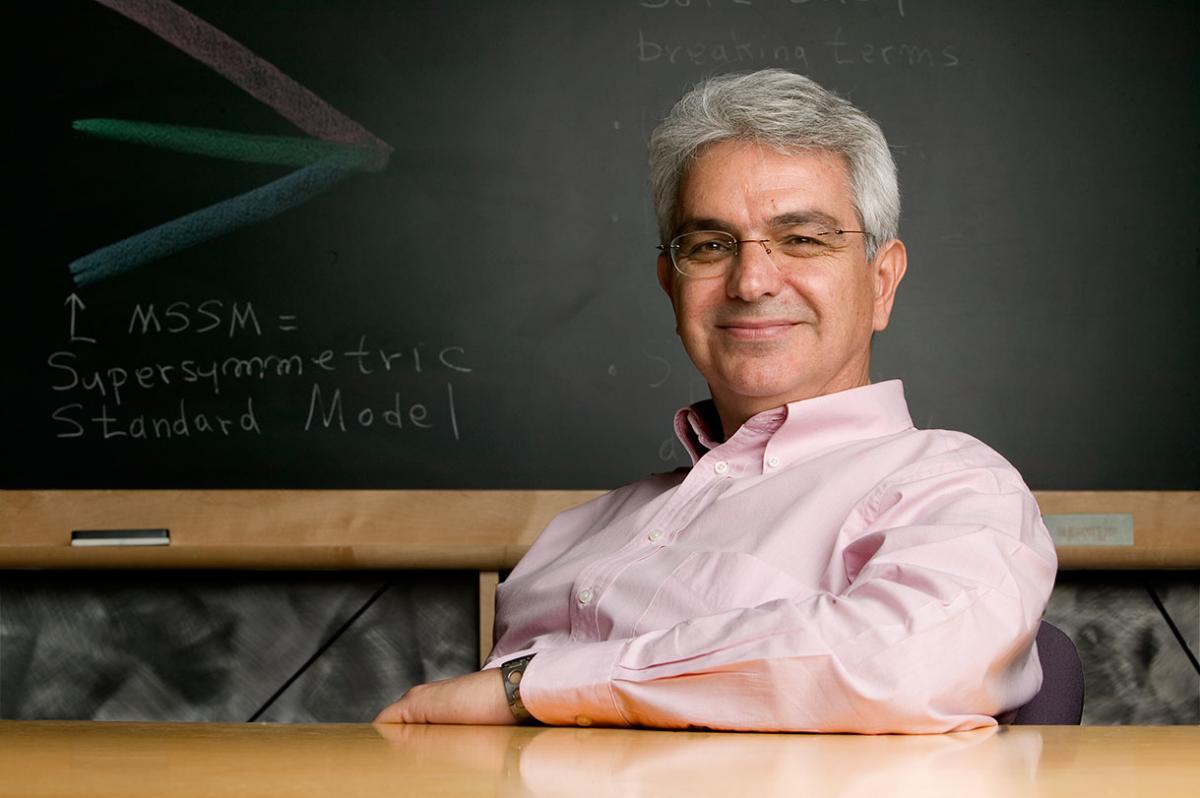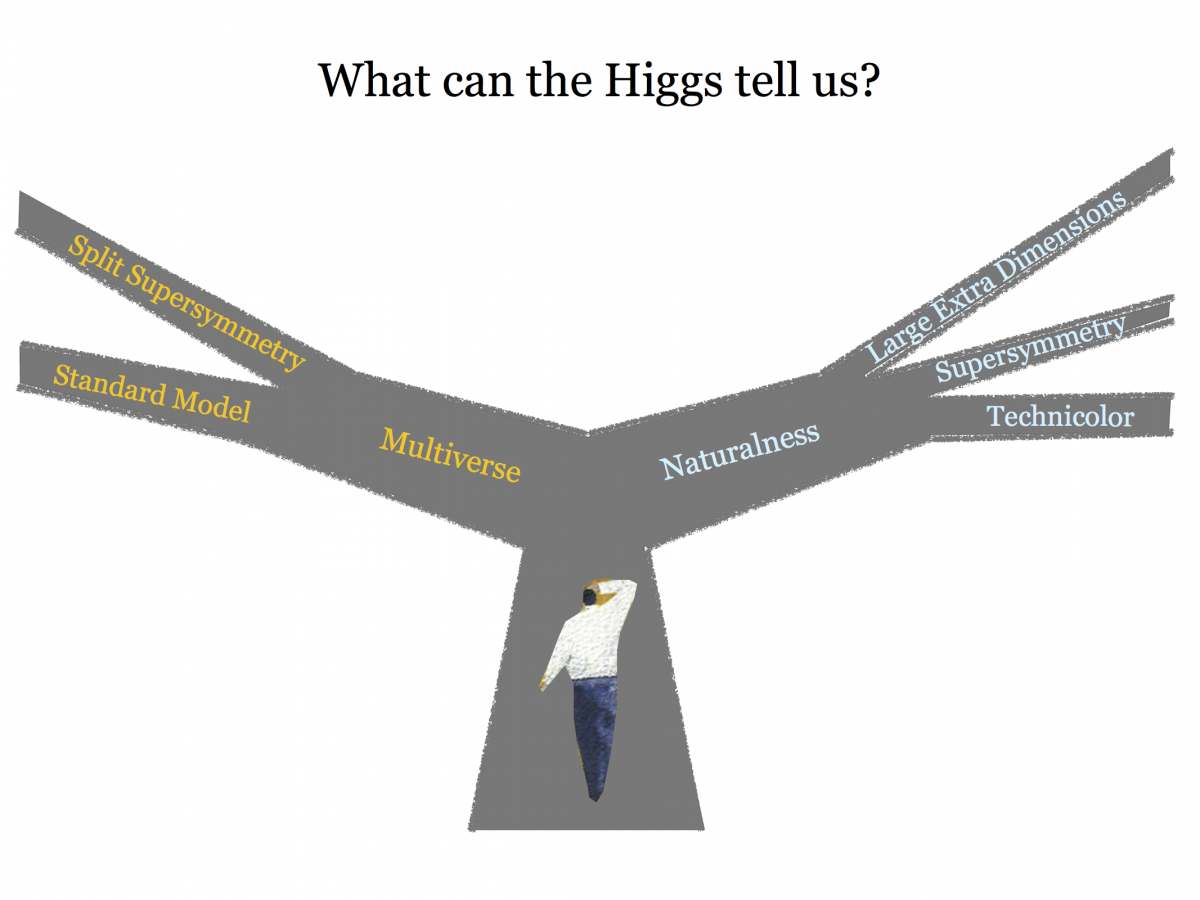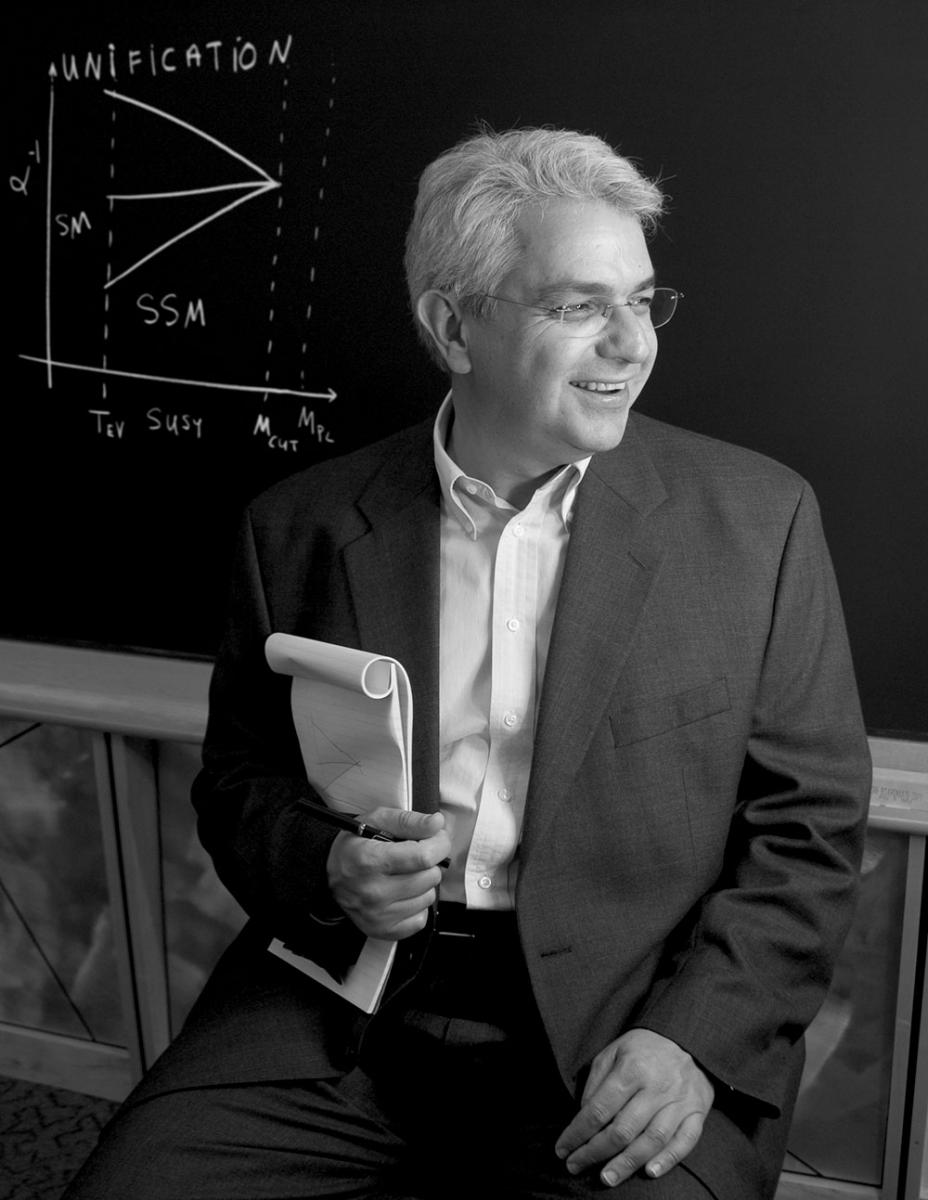Interview with Savas Dimopoulos
Professor Dimopoulos is searching for answers to some of the most profound mysteries of nature. In this interview we discuss the recent findings of the LHC and his expectations about future HEP experiments, the quest for "truth" that seems to inform our scientific endeavours, as well as the relation between science and art.
P.C. Why did you decide to become a physicist?
S.D. What attracted me to physics and mathematics was the truth of the statements made in these disciplines. This dates back to my childhood. I was born in Constantinople, and my family moved to Athens when I was twelve. It was a time of great turmoil and I witnessed political tensions, people on the left and on the right were expressing opposing arguments that both seemed reasonable to me.
I decided to go into a discipline that seeks the absolute truth: a truth that does not depend on the eloquence of the speaker. That limited my choices to mathematics and physics. I finally decided to study physics, as I had doubts about the certainty of truth in mathematics; in physics, in addition to mathematical proofs, the experiments add an extra layer of certainty that brings us closer to the truth.
I was enamoured of the fact that through physics we can explain all phenomena from very few principles, as nature turns out to be exceedingly simple in principles and exceedingly complex in phenomena. The laws of nature can be written down on a single piece of paper and explain everything that we have seen so far in the universe. This is the magic of theory: it compactifies facts and reduces them to a handful of principles from which everything can be derived.

P.C. You referred to the balance between experiment and theory, but it somehow seems that you were more intrigued by the latter. What attracted you to what is now called theoretical physics?
S.D. In the beginning, I had not decided whether I was going to be a theorist or an experimentalist. I went to a high-school without laboratories in Greece. The first time I had the chance to work in a laboratory was as a student at the university. That’s when I realised that I lacked the talent to be an experimentalist and felt that I was better in theory.
At the time, I thought that the truth of mathematics exists only in our human brains, whereas physics is independent of human existence and therefore the ultimate discipline for the search for the absolute and most important truths. Plato believed that mathematical reality in some sense exists in the so-called platonic world of ideas, where objects on earth have their idealized counterparts. A sphere, for example, is never perfect in real life but in the platonic world, which we call mathematics, perfectly round spheres exist. As mathematical entities are not necessarily realized in nature, I felt uncomfortable as a child to just focus on mathematics. However, I think that it is an amazing language. The rules are well defined and once you pose the right question anybody can follow the steps to find the correct answer, even computers.
P.C. Do you think that, besides experiments, mathematics is also another way to control our theories?
S.D. You are absolutely right. Mathematics is crucial for controlling the truth because it is not a random game. You start with a few axioms, and, as long as they are self-consistent, you can produce theorems and derive truths that follow from them. In that sense, mathematics is very important to theoreticians, as mathematical consistency is a huge constraint on our theoretical ideas.
P.C. What is the situation today in theoretical physics, following the recent results of the LHC?
S.D. We are now standing at a crossroads, with one path leading to naturalness and the other to the multiverse or something else. It is very exciting, we are testing if the idea of naturalness can be applied to the hierarchy problem – which is the disparity between the weak and gravitational forces. In the next several years, the LHC will be the epicentre of excitement, because it is testing such a fundamental principle and such a dichotomy in physics.
In the light of these data, physicists react in different ways. As I often emphasize in my recent talks, the state of beyond Standard Model physics after the LHC8 can be compared to headless chickens running in all possible directions. What is more interesting, headless chickens can live for up to two years; that is also the timescale which we need to get more results from the second run of the LHC. This run will indicate the research that we will pursue in the coming decades.

Mixed reactions should not frighten us, as they characterize every scientific revolution.
P.C. Why do you believe there is so much enthusiasm for the search of supersymmetry at the LHC?
S.D. People are enthusiastic about the possibility of discovering supersymmetry for a number of reasons. In the early 1990s, LEP measured the strengths of the strong and weak electromagnetic interactions and discovered that supersymmetric grand unification is favoured over the non-supersymmetric one. That was a great source of excitement, and theorists looked forward to discovering the super-partners at LEP, LEP 2, or at the LHC. However, no hint of supersymmetry was found after the first collisions at the LHC8 energies.
This story reminds me one of Sherlock Holmes’ stories where he points out “the curious incident of the dog in the night-time”, the incident being that the dog did nothing. In the same way, the absence of supersymmetry at the energies explored so far at the LHC can teach us many things. Supersymmetry is one of the rare ideas that is so important, that even its absence is worth knowing about.
In addition to that, there is also a sociological aspect to the popularity of supersymmetry: it is an easy theory to work with, and, as a result, it can be tested experimentally in great detail, unlike other alternatives to the hierarchy problem.
Because of these reasons, the search for supersymmetry is the primary aim of the LHC. In the next years we should have a better idea of the path chosen by nature and we may be talking with enthusiasm about the discovery of the first supersymmetric particle. In the best case scenario, though, our theories will be proven wrong, and we will discover something unanticipated, something truly revolutionary as was the case with quantum mechanics.
P.C. How did it feel to have your prediction of unification of couplings confirmed by experiment?
S.D. Having your theory confirmed by experiment feels like a present that you didn't deserve. When we do science on a day-to-day basis, it’s sort of like a puzzle – this very intricate game with strict rules. It’s like nature is a giant puzzle and mathematics is the language of nature. When a mathematical theory is verified by experiment, you feel an awe. It somehow becomes real. You get amazed when you realize that all these games you have been playing are not just games but actually describe nature.
P.C. Do you think LHC will have the last word or will we also need to design new experiments?
S.D. There are two directions that we should pursue vigorously. One is to continue with colliders, and go to much higher energy. The other is to design new experiments, as there are some great theoretical ideas that cannot be tested in colliders. For example, some very weakly interacting new particles such as the axion can only be discovered in low energy, tabletop, small-scale experiments.
There can be forces that are too weak to be discovered in colliders but can nevertheless be observed by testing gravity-like forces in small scale. For example, one can look for deviations from Newton's law at short distances. In addition to the theoretical importance, many fields (i.e. condensed matter physics, atomic physics, quantum information) have made great progress in precision studies, and these new techniques are begging to be used for fundamental discoveries. They also have the sociological advantage of shorter timescales, typically less than five years, compared to those between two consecutive colliders, which can be decades.
Another interesting point is that you can roughly separate physics to two periods. Before WWII a number of techniques were used to explore the truth, and the job of theoreticians was both to come up with theoretical ideas and to design experiments to test them. Enrico Fermi and Felix Bloch, for example, did not just do theory; they came up with experiments and, in some cases, even conducted them themselves. After the War, fundamental physics started focusing increasingly on the high energy frontier. This has been a golden road, as the recent discovery of the Higgs shows. Nevertheless, in the long timescale between consecutive colliders, it will be exciting to look for new physics using low energy experiments.
P.C. Do you think that we still learn something, even when our theories are proven wrong? Is this another step bringing us closer to truth?
S.D. Absolutely. Truth is both discovering new things and proving that some preconceptions, speculations, or theories are wrong. For example, the idea of the aether seemed plausible at a time, as it was logical to assume that electromagnetic waves need a medium, but it was disproved by the Michelson–Morley experiment. In this case, it was the non-discovery of something that created the big earthquake that led to relativity. Knowing what is false can be as important as knowing what is true.

P.C. What drives people to formulate new theories and models?
S.D. One obvious reason is the inconsistency of an existing theory with data. The Standard Model has survived every laboratory test so far and in some cases the validity of its predictions has been tested to 12 decimal precision. It nevertheless fails to explain roughly 95% of our Cosmos. It does not explain Dark Matter or what the origin of Dark Energy is. For the latter, the SM prediction is at least 60 orders of magnitude larger than what we observe it to be. In addition to all this, we eventually run into theoretical problems once we extrapolate the theory to high energies.
The other motivations are beauty and economy. In the context of physics, the idea of beauty has a
relatively precise meaning: it involves symmetry, i.e. the idea that one object appears the same from different perspectives. Economy refers to economy of structure, particles, and parameters. Ideally, there are as few “moving parts” postulated into the theory as possible. In that sense, it is hard to believe that the Standard Model, despite being an amazing theory, is fundamental, because it has over twenty parameters and tens of particles. There must be a more economic version.
A philosophical, more reflective reason for doing theory is our love of patterns. We are pattern junkies. In our effort to find harmony and conceptually beautiful ways to understand everything at the deepest possible level we do science or create art. Neither of them directly enhances or contributes to our survival probability, but the least important things for our survival are the very things that make us human. For me, art and science are equally important; after a hard day of research I listen to music and find these patterns very relaxing because they are beautiful, and also because I don't have to actively scrutinise them.
P.C. Is it possible that at some point we will have answered all the fundamental questions and the scientific endeavours will come to an end?
S.D. Humans tend to be quite dismissive of the things they learn. There is a famous saying: “Yesterday's sensation, today's calibration, tomorrow's background”. We get bored, and want to move immediately to the next level. For many decades, if not centuries, we have been trying to find a model that explains all the interactions to any conceivable energy that we have experimented with so far. We came up with the Standard Model that may describe almost all known phenomena, but now we want to effectively build a meta-theory that explains the theory itself. However, I am sure that even if we find this meta-theory, we will still come up with more questions. That's what makes us, as humans, a progressive species: we get excited, we investigate, we discover, and then we get bored and want to get excited again by moving to the next questions.
P.C. Do you think that the social context is still in favour of researching particle physics and fundamental questions?
S.D. I think that the public is very interested in fundamental physics. Physics enrolment at universities like Stanford has been going steadily up for the last 15 years at undergraduate and graduate level, despite the fact that there are more competing disciplines, such as biology and information technology. I have also received a lot of positive feedback from the movie Particle Fever. However, when the producer approached me ten years ago and told me that he wanted to make a movie about particle physics, I said: “That sounds boring. Who cares about particle physics? You are wasting your time”. “It's not about particle physics,” he replied, “it's about particle physicists”. I said: “This is even worse. They are the plainest people on the planet”. I was proven blatantly wrong. And it's not just Particle Fever. This year there are several movies about science: Gravity, Interstellar, the Imitation Game that is about Alan Turing, and The Theory of Everything about Steven Hawking.
I think that part of the reason why many more young people don't go into physics in general and particle physics in particular is that we are not very good at communicating the sense of excitement or even the practical importance of our discoveries to the public. If more effort is put in that direction, it will do wonders to attract bright young people.
Outreach is a little easier for astrophysicists and cosmologists, because people can lift their eyes to the sky and see what they talk about. Our job, however, is to explain that big entities consist of small parts, which, in a sense, are more fundamental.
In my experience, two books that I read when I was twelve played a big role in my choosing to be a physicist. One was by Einstein and Infeld and the other was a biography of Einstein by Philipp Frank.
P.C. Maybe this is the right time to ask you, as a teacher now, what's your main advice to your students?
S.D. Enjoy yourself and work on the biggest problems that you can tackle.
The author would like to thank Athena Papageorgiou Koufidou for her invaluable help in editing this interview and for joining him during a midnight skype conversation with Prof. Dimopoulos on a Christmas’ Eve.
